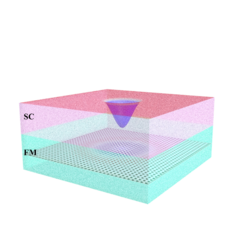Study of the skyrmion-superconductor interface in van der Waals heterostructures
Supervisor: Prof. Dr. Stuart Parkin
Responsible Scientific Pillar Coordinator: Dr. Abhay K. Srivastava

Magnetic skyrmions, topologically protected nanoscopic spin textures, are considered the next-generation information carriers in future memory devices. These skyrmions are stabilized in non-centrosymmetric magnets. Similar to these skyrmions, another topological excitation known as vortex is found in superconductors. A heterostructure consisting of a non-centrosymmetric magnet and superconductor could lead to a pairing of these textures [1, 2]. It has been proposed that such heterostructures could result in topological superconductivity leading to Majorana Fermions [3, 4]. Studying the behavior of superconducting vortices in the vicinity of skyrmions could shed light on their coupling mechanism.
This project involves the fabrication of van der Waals heterostructures and performing magnetic imaging measurements utilizing state-of-the-art Lorentz Transmission Electron Microscopy and/or Magnetic Force Microscopy systems at temperatures below 50 K. The project aims to investigate ferromagnet-superconductor heterostructures to understand and manipulate the coupling between skyrmions and vortices. In this project, the candidate will learn in detail about spintronic and superconducting phenomena by exploring the complete process of fabricating micron-sized devices and visualizing/manipulating spin textures that are smaller than 100 nm. The candidate will have the opportunity to work in a dynamic and collaborative environment.
The following methods and instruments are available for working on the topic: Glove box, Optical Lithography, Focused ion beam, PPMS, SQUID, Lorentz Transmission Electron Microscopy, Magnetic Force Microscopy. It is expected that the doctoral candidate has an excellent understanding of solid-state physics, especially magnetism and superconductivity, and has prior experience working on any of the above-mentioned experimental systems.
Literature:
[1] K. M. D. Hals et al., Phys. Rev. Lett. 117 (2016)
[2] S. M. Dahir et al., Phys. Rev. Lett. 122 (2019)
[3] W. Chen and A. P. Schnyder, Phys. Rev. B 92 (2015)
[4] U. Güngördü et al., Phys. Rev. B 97 (2018)
Contact:
For scientific questions about the possible PhD topic, please contact Dr. Abhay K. Srivastava. For formal questions regarding the application, please contact Michael Strauch.
